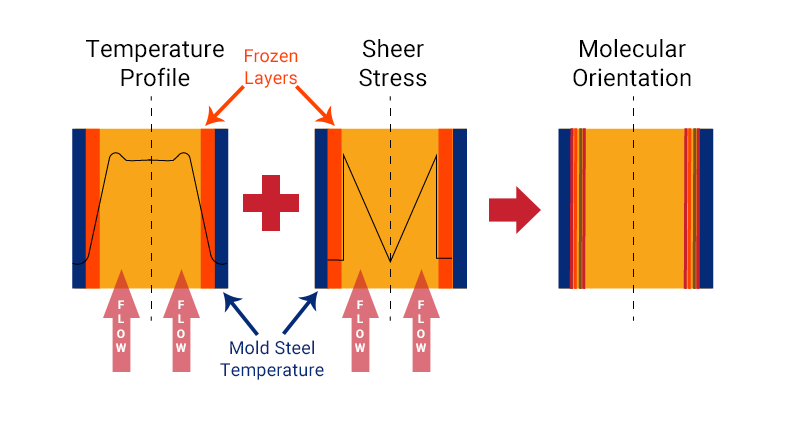Injection molding is a complex manufacturing process involving temperature and pressure. During the molding process polymer materials experience complex molecular chain deformation while undergoing temperature and pressure changes. Molded part properties and performance are dependent on, and influenced by, design complexity and the molding process. Understanding molded-in stress, specifically flow induced molded-in stress, is an important aspect of molding high quality parts.
Molded-in stress, also called residual stress, results from material being processed under less-than ideal conditions during injection molding. Stresses can be either flow-induced or thermally-induced. Flow-induced stresses are generally much lower than thermally-induced ones. Molded-in stress causes shrinkage and warpage in molded parts.
Molded-in stresses are developed during cavity filling when the polymer’s molecular chains are stretched and then align with the direction of flow. At the intersection of the mold and the cavity the cooling rate is high. Here the aligned molecules can be frozen in the elongated state. Because of the rapid cooling rate, they do not have time to relax and return to their natural curled formation. These flow-induced frozen-in molecular orientations depend on flow speed, melt and mold temperatures, molecular weight distribution, and chain branching.

The image on screen is a cross-section of a molded part. Here you can see that the polymer temperature at the intersection of the mold wall is very close to the mold temperature. Directly beneath the frozen layer the polymer temperature is the highest due to high shear rates at the intersection between the frozen layers and the flowing polymer. Because of the polymer flow behavior, the molecular chains get oriented along the mold wall and the frozen layer.
All injection molded parts have a certain amount of molded-in stress. It is helpful to understand and analyze flow-induced stresses to determine if they will result in molded part defects. For more in-depth information, the full lesson is available here.

Questions, Comments or Feedback…
You must be logged in to post a comment.